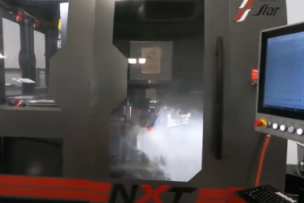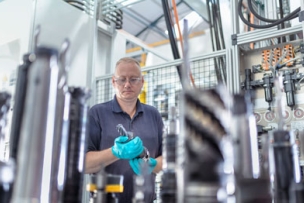Lessons in High-Performance Machining: Don't Forget the Tool Holders
Between hard metal materials, high speeds and feeds—and tool balancing—tool holders are a lot more important to your part-building success on a high-performance machine than you might realize. Learn why.
So your shop just bought a new high-performance machining center. It boasts some impressive specifications including a 20,000 rpm spindle, a rapid traverse rate of 2,400 ipm and feed rates to match. It’s far faster than anything else on the floor. Everyone is enjoying the staccato sound of chips against the sheet metal and the low hum of the spindle motor deep in a cut.
There’s only one problem: At these new and improved higher spindle speeds, the chatter has everyone scrambling for earplugs. Tool life is deteriorating. When cutting the 17-4 PH and Triple 5 titanium aerospace parts the boss started bringing in recently, tool pullout has been a big problem. The result? The piles of parts that were supposed to be made every day from the investment in a HPMC simply aren’t showing up.
In all fairness, you might also have these complaints about the older, less capable machining centers. In fact, it might have been one of the drivers for a new machine in the first place. Sorry to tell you this, but the problem is most likely that the side-lock end mill holders and ER-style collet chucks you’ve been using for decades are not appropriate for modern machining technology.
“You have the machine tool capable of high speeds and feeds, the cutting tool with the latest geometries and coatings, and with the tool holder being the interface between the two, why cut corners?” says Ronald West, senior global product manager at Kennametal. “With today’s machine tools capable of higher speeds and feeds, toolholding has become more important than ever to take advantage of the capabilities of high-performance cutting tools.”
Some manufacturers place their investments in the machine and the latest tooling and cutting technology, but it’s not uncommon to see many firms use a commodity tool holder that is not right for the job. Yet, it’s one of the most important elements in today’s high-performance environments—especially in aerospace applications where you are working with advanced materials, explains West.
“Side-lock holders are still prominent in the industry, but it’s really doing a disservice to the investment in carbide cutting tools companies are buying now,” says West. “The tool holder needs to match up with the kind of high-performance machine being used today.”
Stop the Tool Movement, Avoid Extra Scrap, Save Your Tool Life
Consider tool pullout. Machining of titanium and other heat resistant superalloys generate high cutting forces not only in the axial and radial direction, but also in the axial direction which can result in tool pull out. It is even more important to use the right type of tool holders to prevent tool failure and part scrap. It might not be much—maybe just a few thousandths of an inch at a time, but chances are good that it’s enough to scrap out some very expensive parts. Grind all the grooves and flats you want on the tool shank, it’s still going to move, most likely when you least expect it.
The best solution is a tool holder specifically designed to eliminate pullout. Many vendors license Haimer’s patented Safe-Lock technology. All will beat the pants off a traditional side-lock holder while improving runout characteristics. Here’s a small sample of some of the available solutions:
- Sandvik Coromant’s CoroChuck 930 hydraulic end mill holder uses a “fulcrum” style two-point mechanism to prevent movement.
- Kennametal’s HydroForce™ hydraulic chuck for heavy milling claims exceptional runout and accuracy—and an optional SAFE-LOCK sleeve helps avoid pull-out in difficult-to-machine materials (such as those used in the aerospace and energy industries).
- The Mega Perfect from Big Kaiser accepts Weldon flat end mills but is said to eliminate slip and pullout.
Want to get the most out of your metalworking efforts? Read “How to Maximize Machine Productivity with Tool Holders.”
Control the Harmonics, Chatter and Spindle
You’re spinning tools faster than ever before, and the runout you’ve been living with for years will quickly beat the heck out of even the best milling cutter. As if poor tool life isn’t bad enough, the higher rpm generates the harmonics that lead to chatter, possibly followed by spindle damage thanks to an unbalanced situation.
You have several options to manage these higher speeds, feed chatter and harmonics issues, including: shrink-fit toolholding, hydraulic chucks and mechanical milling chucks. You should test each one for yourself, documenting the results and making your decision based on performance on your machines, not price.
Shrink-Fit Toolholding
You’re going to need a shrink machine, and you’ll spend an extra minute or two heating and cooling the holder with every tool change, but many shops swear by the extreme accuracy and inherent balance of shrink-fit toolholding. Haimer says it’s less than 40 seconds total.
Hydraulic Tool Holders and Chucks
Hydraulic chucks are accurate, simple to use and offer robust toolholding capabilities. Kennametal’s HydroForce™ is one used for heavy milling, for example, that claims three times the clamping force of conventional hydraulic chuck systems and needs nothing more than an Allen wrench to operate. HydroForce chucks have a dampening capability which improves tool life, especially when machining titanium and other high-temperature alloys.
Mechanical Milling Chucks
Schunk, Iscar, Guhring and others market mechanical milling chucks rated to 20,000 rpm and runout to 0.0002-inch or better (as do Sandvik Coromant, Big Kaiser and others). Again, operation is simple, with rigidity and clamping forces much higher than the 100-year-old Weldon flat.
Speaking of legacy toolholding, hopefully your new machine came with an HSK, Capto, KM4X or a comparable spindle. CAT and BT-flange are perfectly fine for less demanding work, but plowing through HRSA materials or surfacing a die cavity at high spindle speeds calls for a modern spindle interface.
"You can show workpiece performance improvements with the right tool holders. It's something that is easy to overlook, but makes a huge difference."
At These Machine Rates, You Need Tool Balance
Most tooling experts say that balanced tool holder assemblies are a must for spindle speeds 20,000 rpm or higher, while others suggest that the bar is lower.
“When you’re running machine tools that fast, usually over 12,000 rpms, it’s recommended to always balance the complete system, (i.e. toolholder with the cutting tool),” says West. “It just increases tool life and decreases spindle wear … It’s a little more difficult with a collet chuck or end mill adapter to maintain balance due to their design and required hardware, but typically hydraulic chucks and shrink fit adapters are much easier to fine balance for high speed applications.”
At 6,000 rpms you’re not going to notice the imbalance as much, notes West, but with the higher speeds, tool balance is crucial—and something that can be misunderstood when talking about toolholders.
To help, a special balancing machine is required, as is additional effort during the tool presetting process. Be sure you are presetting. Pre-balanced tool holders will not be sufficient since the entire assembly including the cutting tool and retention knob (for those with CAT and BT machines) must be balanced as one piece. Following these recommendations and including routine maintenance to extend tool life reduce downtime and help you make better parts.
“You can show workpiece performance improvements with the right tool holders,” says West. “It’s something that is easy to overlook, but makes a huge difference.”
Have you noticed the difference a tool holder can make in a high-performance machining center? Share your experience.




Talk to Us!
We at The Factory Link represent the top end holders with mechanical (SCM) and Hydraulic (ETP). We can assist you with your tooling needs through our distribution network in OH,KY,IN and Michigan.
38Leave a reply
Your email address will not be published. Required fields are marked *